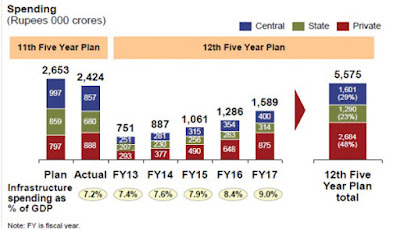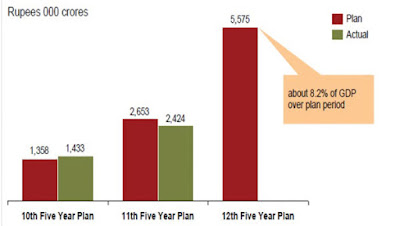At
A Glance - Construction Industry in India - 1
Construction equipment industry
in India makes a significant contribution to the country's GDP. Construction sector in India is
considered to be the second largest employer and contributor to the economic activity,
after agriculture sector. Construction sector also accounts for the most inflow
of Foreign Direct Investment (FDI) after the services sector and employs more
than 35 million people in the country. Around 50 percent of the demand for
construction activities in India comes from the infrastructure sector, while
the rest comes from industrial activities, and residential and commercial
development. Indian construction industry's value is estimated to be more than
$126 billion.
Image Credit - NBM&CW
Infrastructure growth holds the key to the industry,
realizing its potential in India. In the 12th Five Year Plan, the government
earmarked approximately $1 trillion for infrastructure investment, with 40
percent of the funds coming from the private sector. In order to attract such
investment, the Indian government eased FDI norms for quite a few sectors of
infrastructure development. This is likely to spur the demand for the
earthmoving and construction equipment, and if the industry's full potential is
realized, the result could be a $16 billion to $21 billion industry by 2020.
There is a multitude of construction equipment manufacturing
companies that are designing copper-bottomed cranes, material handling
equipment, and fabrication materials. A crane is a device that uses one or
more simple machines to create mechanical advantage and
thus, moves loads beyond the normal capability of a human. Over the years,
cranes have perceptible undergone transformation. They are being used in different
industries for carrying out various tasks. Loghandling crane manufacturers in Bangalore SGF Fab
provide 12 distinctive varieties of crane that are reliable and efficient.
Monorails manufacturers in Bangalore SGF Fab are affording infallible
construction equipage from ages. These precast
handling crane manufacturers provide an array of cranes, material handling
equipment, and industrial fabrications that hasten the construction process, or
any other type of job. What distinguishes them from their contemporaries is the
customization of equipage.
The 12th Five
Year Plan
India's need for infrastructure
development was also supported by the government's intentions as outlined in
the 12th Five Year Plan (FYP). Infrastructure was one of the plan's primary areas
for spending, with about $1 trillion (Rs.55 lakh crores) earmarked for
investment. Five sectors accounted for more than 80 percent of total planned
spending: electricity, telecom, roads and bridges, irrigation, and railways,
including mass rapid transit systems.
Image Credit - NBM&CW
Overall, infrastructure spending was expected to grow from
7.2 percent of GDP in the 11th FYP to 9 percent by fiscal year 2017. Private
investment in infrastructure was expected to increase from Rs.8.8 lakh crores
in the 11th FYP to Rs.26.8 lakh crores in the 12th FYP. More than 80 percent of
private-sector spending was expected to continue (2017) to focus on four
sectors: telecom, electricity, roads & bridges, and renewable energy.
Private investment in infrastructure was expected to increase from 37 percent
in the 11th FYP to 48 percent in the 12th FYP. This growth was expected to be
spurred by private players' expected capacity expansion and their ability to
provide good quality, timely service while keeping costs low.
(This blog will be published in several series to cover the
sum and substance of the industry.)


Comments
Post a Comment